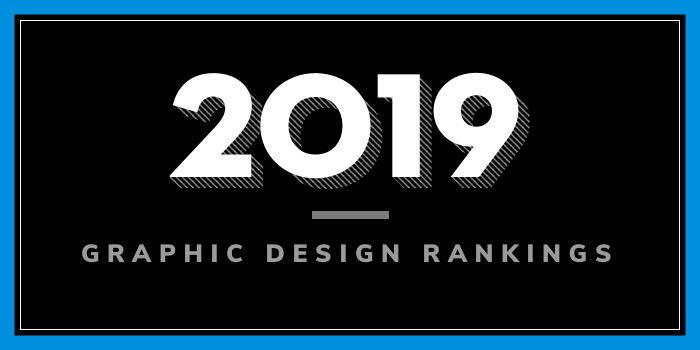
| Ranking | School | State | % |
|---|---|---|---|
| 1 | Virginia Commonwealth University | Virginia | Top 1% |
| 2 | North Carolina State University at Raleigh | North Carolina | 1% |
| 3 | University of Texas at Austin | Texas | 1% |
| 4 | University of North Texas | Texas | 2% |
| 5 | University of California-Los Angeles | California | 2% |
| 6 | University of Illinois at Chicago | Illinois | 2% |
| 7 | Arizona State University | Arizona | 3% |
| 8 | Kent State University | Ohio | 3% |
| 9 | University of Cincinnati | Ohio | 3% |
| 10 | University of Washington | Washington | 4% |
| 11 | University of Illinois at Urbana-Champaign | Illinois | 4% |
| 12 | Portland State University | Oregon | 4% |
| 13 | Auburn University | Alabama | 5% |
| 14 | Clemson University | South Carolina | 5% |
| 15 | Fashion Institute of Technology | New York | 5% |
| 16 | The Ohio State University | Ohio | 6% |
| 17 | Appalachian State University | North Carolina | 6% |
| 18 | Massachusetts College of Art and Design | Massachusetts | 6% |
| 19 | Iowa State University | Iowa | 7% |
| 20 | University of Georgia | Georgia | 7% |
| 21 | University of Tennessee | Tennessee | 7% |
| 22 | Colorado State University | Colorado | 8% |
| 23 | Louisiana State University | Louisiana | 8% |
| 24 | California State University-Long Beach | California | 8% |
| 25 | East Carolina University | North Carolina | 9% |
Our 2019 rankings of the Top 25 Public Graphic Design School Programs in the US. We considered 303 public colleges with graphic design programs for this year's rankings. For an explanation of ranking criteria, click here.
 1. Virginia Commonwealth University, Richmond, Virginia (top 1% of colleges considered)
1. Virginia Commonwealth University, Richmond, Virginia (top 1% of colleges considered)
Virginia Commonwealth University (VCU) was established in 1838. It is home to more than 31,000 students enrolled in more than 200 programs through 15 colleges and schools. The School of the Arts, which serves more than 3,000 students, offers 25 degree programs. An additional four programs are offered at VCU’s Qatar campus. The School of the Arts (VCUArts), Department of Graphic Design, has several programs for aspiring graphic designers. Options include BFA degrees in Graphic Design and Communication Arts, and an MFA with a Concentration in Design/Visual Communications.
Per the Department, students in the MFA program “concentrate on the philosophical, communicative, and aesthetic relationships of visual problem solving and the interacting skills leading to the effective articulation of concepts.” BFA students will take courses in the areas of Publication and Print Design, Sequential and Motion Design, and Interaction Design, “along with a series of related Studio and Seminar courses.” Both BFA options prepare students to create effective visual communications.
 2. North Carolina State University at Raleigh, North Carolina (top 1% of colleges considered)
2. North Carolina State University at Raleigh, North Carolina (top 1% of colleges considered)
Founded in 1887, North Carolina State University at Raleigh (NC State) is home to around 35,480 students enrolled in 300 undergraduate and graduate degree programs. Known as “the school of 100+ startups and spinoffs,” NC State houses 12 colleges and 65 departments. The College of Design is home to the Graphic Design program which offers two degree paths—a Bachelor of Graphic Design and a Master of Graphic Design.
The College has recently established a PhD in Design/Information Design Concentration as well. The undergraduate and graduate degrees are NASAD (National Association of Schools of Art and Design) accredited and the PhD program is set to receive NASAD approval after graduating its first class.
Per the College of Design, students in the undergraduate program study comparative ideas about, and methods for, creating visual communication. Sequenced core studios, typography courses, and image-making courses “progressively introduce and develop skills, processes, and sensitivities across a range of media.” Graduate students will “closely examine the cultural and technological situatedness of graphic design and its products, and to seek understanding of the people who use and interact with the things that graphic designers make.”
 3. University of Texas at Austin, Texas (top 1% of colleges considered)
3. University of Texas at Austin, Texas (top 1% of colleges considered)
The University of Texas at Austin (UT Austin) was founded in 1881. The school opened its doors in 1883 with one building, eight professors, one proctor, and 221 students. Today, UT Austin is home to nearly 52,000 students enrolled in over 500 degree programs and fields of study across 18 colleges and schools. The College of Fine Arts, Department of Art and Art History has several programs for aspiring graphic designers. Options include BA, BFA and MFA degrees in Design, and a BFA in Visual Studies.
Students in all programs have the opportunity to complete an internship, which may include working at major companies with offices in the Austin area. Just a few include Google, Dell, IBM, Apple, Samsung, Frog, Pentagram, and EA Games.
 4. University of North Texas, Denton, Texas (top 2% of colleges considered)
4. University of North Texas, Denton, Texas (top 2% of colleges considered)
University of North Texas (UNT) was founded in 1890 as Texas Normal College and Teachers’ Training Institute. With 38,000 students enrolled, UNT is the fourth-largest university in Texas. The school offers 105 bachelor's, 88 master's and 37 doctoral degree programs across 11 colleges and schools. The College of Visual Arts & Design is home to the Design Department, which houses the Communication Design Program. Program options for aspiring graphic designers include BFA, MA, and MFA degrees in Communication Design.
The BFA program covers the basic principles of design, image making, color theory and typography. It is also designed to “help students learn to be effective conceptual thinkers and, most importantly, creative problem solvers in the disciplines of Advertising and of Graphic Design.” The 36 credit hour MA in Communication Design and the 60 credit hour MFA in Communication Design are both taught as concentrations in Design Research.
Students in all Graphic Design programs have the opportunity to complete an internship, study abroad, and access “valuable resources” consisting of over 1,000 reference books, magazines and paper/print samples of photography, illustration, typography, graphic design and advertising.
 5. University of California Los Angeles (UCLA), California (top 2% of colleges considered)
5. University of California Los Angeles (UCLA), California (top 2% of colleges considered)
The University of California Los Angeles (UCLA) was founded in 1919 as the Southern Branch of the University of California. It is home to nearly 45,500 students from all 50 states and more than 100 foreign countries. The UCLA College and 12 professional schools offer more than 5,000 courses in 125 undergraduate degree programs, 98 master’s programs, 109 doctoral and professional programs, and 91 minors.
The School of Arts and Architecture is home to the Department of Design Media Arts (DMA), which offers both BA and MA degrees in Design Media Arts. Per the school, the DMA program “emphasizes innovative creation with digital and mass media within the context of a public research university.” The curriculum highlights “a solid foundation in form, color, space, motion, typography, and interactivity, followed by a broad selection of area studies courses in video, visual communication, network media, game design, and narrative.” The senior project allows students to focus on individual interests within the areas of Visual Communication and Image, interactivity and games, or video and animation.
“This uniquely challenging and diverse program invites students to balance aesthetic sensibility with logical reasoning, formal theories with practical application, and contemporary thought with historical perspective.” With courses that are taught as studios of no more than 22 students, individual growth and a sense of community within the department is encouraged.
 6. University of Illinois at Chicago, Illinois (top 2% of colleges considered)
6. University of Illinois at Chicago, Illinois (top 2% of colleges considered)
The University of Illinois at Chicago (UIC) was formed in 1982 by the consolidation of two U. of I. campuses: the Medical Center campus, which dates back to the 19th century and the comprehensive Chicago Circle campus which replaced, in 1965, the two-year undergraduate Navy Pier campus that opened in 1946 to educate returning veterans. Serving nearly 31,700 students, UIC is the largest university in Chicago.
The school, which has regional campuses in Peoria, Rockford, Springfield, Urbana, IL, and The Quad Cities, offers 248 degree programs and 32 certificates across 15 colleges. The College of Architecture, Design, and the Arts houses the School of Design, which offers a Bachelor of Design (BDes) and a Master of Design (MDes) in Graphic Design.
The four-year BDes program highlights studio-based instruction, while the two-year MDes focuses on an independent master’s research project. A third option is the MDes Prelim Program. Offered to applicants who do not hold a bachelor’s degree in design, the Prelim Program is a customized yearlong program that prepares students for the two-year MDes.
 7. Arizona State University, Tempe, Arizona (top 3% of colleges considered)
7. Arizona State University, Tempe, Arizona (top 3% of colleges considered)
Founded in 1885, Arizona State University (ASU) is home to more than 100,000 students (2017) enrolled in over 290 academic undergraduate programs and hundreds of graduate programs across 17 colleges and schools. The Tempe campus is home to nearly 52,000 students, making it the largest campus in the ASU system.
The ASU Herberger Institute for Design and the Arts houses the Design School, which offers programs in the areas of Architecture, Environmental Design, Industrial Design, Interior Design, Landscape Architecture, Urban Design and Visual Communication Design/VCD (Graphic Design). Visual Communication Design (VCD) options include a BSD in Graphic Design, an MSD with a Concentration in Visual Communication Design (VCD MSD), and a Master of Visual Communication Design (MVCD).
The BSD allows students to work on projects in the areas of Information Design, Interaction Design, Exhibition Design, Animation, Motion Graphics, Branding, Publication Design, Web Design, Interface Design and multiple contemporary facets of sensorial design. The MSD for individuals interested in “advanced studies in visual language, history, theory, criticism and methodology, design processes and technology.” The degree “develops an understanding of contemporary graphic design issues through specialized research and design skills. It also prepares the graduate student for a career in graphic design education.”
The MVCD has two options—a two-year studio-based program and a 3+ program. The two-year studio program is designed for students with a degree in VCD or Graphic Design and a 3+ program is designed to be a first professional degree for those students who do not have an undergraduate degree in VCD or Graphic Design.
 8. Kent State University, Kent, Ohio (top 3% of colleges considered)
8. Kent State University, Kent, Ohio (top 3% of colleges considered)
Kent State University (KSU or Kent State) was founded in 1910 and it is home to more than 38,000 students (in an 8-campus system) enrolled in more than 300 degree programs across dozens of colleges and schools. The College of Communication and Information, School of Visual Communication Design, offers several programs for aspiring graphic designers including BFA, MA, and MFA degrees in Visual Communication Design and a Design Minor.
Per the School, the BFA program consists of approximately two-thirds of the coursework in the "creation and study of the visual arts," with the remainder in general studies. Because of the greater emphasis on upper-level studio courses, the BFA allows majors the opportunity to build greater expertise in a given area of the field.
The MFA is one of only three programs in the state to offer the Master of Arts degree in Visual Communication Design and was the first to offer the terminal degree in the field, the Master of Fine Arts. The MA is a 32 credit hour program that prepares students to work in emerging markets such as social media, branding, digital media and user experience design. The MFA “serves students with a strong undergraduate and/or professional experience in design who wish to advance into leadership roles.” Graduates “typically pursue careers in design education, but also stand out in the industry for their ability to solve problems from a research-based design perspective.”
The Design Minor provides students with “grounding in the fundamental elements of graphic design, including design research and history, graphic software, industry standards and professional ethics.” All School of Visual Communication Design students must complete 300 hours of internship before graduation. Most internships are paid, and students have the opportunity to work at major companies across Cleveland and in Chicago, San Francisco and New York.
 9. University of Cincinnati, Cincinnati, Ohio (top 3% of colleges considered)
9. University of Cincinnati, Cincinnati, Ohio (top 3% of colleges considered)
Founded in 1819, the University of Cincinnati (UC) is home to nearly 46,000 students enrolled in 370 degree programs across 13 colleges and a graduate school. The College of Design, Architecture, Art and Planning (DAAP) houses the Myron E. Ullman Jr. School of Design, which offers a BS in Communication Design. The program, which takes five years to complete, offers three Concentration areas including Graphic Design, Motion Design, and Interaction Design.
Students in the BS program will take a broad range of courses such as Foundational Drawing and Design, Kinetic Communication, Typography, Photodesign, and Design Ideation. Courses are supplemented with general education requirements, directed electives, design history, and interdisciplinary courses in design thinking and user-centered design. Per the school, studios “will refine and develop specific or general skills and be enhanced with further study in design history, methodology, research methods, and global studies.”
Besides the BS in Communication Design, aspiring graphic designers might consider another program offered through UC’s Blue Ash College. The Art and Visual Communication Department here offers a two-year Associate Degree in Applied Graphic Communication. The program is designed for “students seeking foundational skills appropriate for further study in the design field or for employment in areas of design support.” Classes are small, so students receive considerable personal attention and direction from faculty. Though the program is a two-year degree, students may take up to three years to complete the program.
 10. University of Washington, Seattle, Washington (top 4% of colleges considered)
10. University of Washington, Seattle, Washington (top 4% of colleges considered)
The University of Washington was founded in 1861. The Seattle campus is home to more than 44,600 students, enrolled in over 165 majors across 16 colleges and schools and in 79 departments. The College of Arts & Sciences is home to the School of Art + Art History + Design (SoA+AH+D), which offers a Bachelor of Design (BDes) in Visual Communication Design and a Master of Design (MDes).
One of the largest undergraduate programs at the University of Washington, Visual Communication Design emphasizes “visual problem solving, organizational skills, and information theory.” Students in the programs engage in all phases of typography, information design, design systems, exhibition design, publication design, new media, and visual methods/processes. Sample courses for the BDes include Typography, Human Centered Design, Color + Composition, Interface Design, Motion Design, Visual Systems, Information Design, and Publication Design.
Sample MDes courses include advanced Design Foundations, Design Methods, Typography, Industrial Design, Interface Design, Case Studies in Corporate Identity, Exhibition and Installation Design, Interaction Design, Information Design, Design Graduate Studio, and Graduate Student Teaching Mentorship.
Students in both programs will have the opportunity to compete for more than 100 seats in the SoA+AH+D study abroad program to explore art, art history, and design in an international context. Past students have studied in Rome, Japan, Spain, and Tuscany.
 11. University of Illinois at Urbana – Champaign, Illinois (top 4% of colleges considered)
11. University of Illinois at Urbana – Champaign, Illinois (top 4% of colleges considered)
Established in 1867 as Illinois Industrial University, University of Illinois at Urbana – Champaign is one of the original 37 public land-grant institutions created after President Abraham Lincoln signed the Morrill Act. The school serves nearly 48,000 students through 15 colleges and instructional units. The College of Fine and Applied Arts, School of Art and Design offers a 122 credit hour Graphic Design program that leads to a BFA. A 64 credit hour MFA in Art and Design with a Concentration in Graphic Design is also available.
Per the school, students in the program “engage with complex problems and are asked to identify opportunities where design can intervene.” Studio work for the program “addresses graphic design fundamentals (typography and image making), design history and contemporary practices, research methods, user experience, and social responsibility.” Students also have the opportunity to refine their degree by choosing from an interdisciplinary selection of elective courses including advanced interaction design, photography, traditional printmaking, sustainability, and video, and the design of Ninth Letter, a nationally-distributed and award-winning literary arts journal.
MFA students have access to individual studio space and specialized resources “essential to the acquisition of a high-quality professional education.” The program requires a graduation exhibition of creative work and a written thesis and admission to the program is determined by a faculty review of a portfolio of the applicant's creative work, records of previous education and experience, letters of recommendation, and other significant achievements that may be viewed as predictors for success in the program.
 12. Portland State University, Portland, Oregon (top 4% of colleges considered)
12. Portland State University, Portland, Oregon (top 4% of colleges considered)
Portland State University (PSU) opened its doors in the summer of 1946 to just 220 students. Today, the school spans 50 city blocks, and it houses nine colleges and schools, 226 degree programs, and more than 25,000 students. The College of Arts is home to the schools of Architecture, Art + Design, Music, and Theater + Film.
With 1,400 students enrolled, the School of Art + Design offers BA, BS, BFA degrees and Minors in areas from Art History to Graphic Design. The Graphic Design Program has two options a BFA and a Minor. Program highlights include mostly studio-based courses, opportunities to engage in professional internships, and summer study abroad experiences such as Printmaking in Mexico and Art History in Rome.
 13. Auburn University, Auburn, Alabama (top 5% of colleges considered)
13. Auburn University, Auburn, Alabama (top 5% of colleges considered)
Established in 1856 as the East Alabama Male College, Auburn University is now home to a co-ed population of 29,776 students enrolled in more than 140 degree options across 13 colleges and schools. The College of Architecture, Design and Construction is home to in the School of Industrial + Graphic Design. Program offerings for aspiring graphic designers include a BFA in Graphic Design (BFA GDES).
The program emphasizes Fine Arts, Exhibitions, Identity Development, Logos, Visual/Digital Interface, Packaging, and Magazine Design. In addition, the school says, “students have excellent opportunities for internship and cooperative education experiences as a result of well established relationships with regional, national and international companies and firms.” Career opportunities range from “the development of strategies to implement large-scale communications campaigns, to the design of effective communication products such as magazines, logo and identity development, interactive media, web design, packaging, exhibitions, illustration, and environmental graphics.”
Auburn GDES is the only Graphic Design Program in Alabama to receive National Association of Schools of Art and Design (NASAD) accreditation.
 14. Clemson University, Clemson, South Carolina (top 5% of colleges considered)
14. Clemson University, Clemson, South Carolina (top 5% of colleges considered)
Founded in 1889, Clemson University serves more than 23,000 students enrolled in more than 270 undergraduate majors, minors, and graduate programs through seven schools. The College of Business, Department of Graphic Communications offers a BS in Graphic Communications that the school says is “dedicated to hands-on learning experiences.” Students in the program are “placed in positions in a variety of printing, packaging, publishing, imaging and related industries in management, marketing, sales, customer service, creative, technical and scientific positions.” The school says that placement rates are “consistently high” with “competitive salaries.”
In addition to engaging in hands-on learning experiences, Graphic Communications students will take courses such as Digital Imaging and eMedia, Packaging Science, Ink and Substrates, Package and Specialty Printing, Commercial Printing, Technical Writing, Current Developments and Trends in Graphic Communications, and Marketing. Graduates of the program are prepared to enter the schools MS in Graphic Communications or seek positions in printing management, production planning and supervision, commercial and technical sales, and many others.
The MS in Graphic Communications includes 33 credit hours of graduate courses for the non-thesis option or 30 hours with a thesis. Within the total requirements, at least 17 hours will be in GC technical/managerial courses; seven will be research related; six credits will be from outside the Graphic Communications Department; and at least one-half will be at or above the 8000 level.
Graduates of the program are placed in positions in a variety of printing, packaging, publishing, imaging and related industries in management, marketing, sales, customer service, creative, technical, scientific and academic positions.
 15. Fashion Institute of Technology, New York, New York (top 5% of colleges considered)
15. Fashion Institute of Technology, New York, New York (top 5% of colleges considered)
Fashion Institute of Technology (FIT) was established in 1944 as the Fashion Institute of Technology and Design.” The institute, which was located on the top two floors of the High School of Needle Trades, opened with just 100 students. Today, the school serves nearly 9,000 students enrolled in dozens of programs in the areas of Art and Design, Business and Technology, and Liberal Arts. The school also offers graduate programs in Art Market Studies, Illustration, and Exhibition and Experience Design, to name a few.
FIT offers a BFA in Graphic Design that highlights courses such as Designing Identities, Typography and Language, Design in the Cultural Context, Color Voyage, Type as Idiom, Graphic Design in Digital Media, Tangible Publication Design, Signage and Graphics, Graphic Design for Packaging, Graphic Design for Toy Designers, and Environmental Graphics.
Per the school, students in the program will work on “real projects for real clients in the Advertising Design Workshop.” They will also “gain first-hand experience through internships at major institutions and design firms, including MoMA, Pentagram, the Art Directors Club, and many others.” All students will have the opportunity to study abroad in England at the London College of Communication, Chelsea College of Art & Design, or Nottingham Trent University.
The BFA in Graphic Design at FIT concludes with a senior thesis project and a juried design exhibition. Graduates of the program will leave FIT with a “strong portfolio to present to potential employers.”
 16. The Ohio State University, Columbus, Ohio (top 6% of colleges considered)
16. The Ohio State University, Columbus, Ohio (top 6% of colleges considered)
The Ohio State University (OSU) was established in 1870. The school serves 68,100 students enrolled in more than 200 majors, specializations, and minors across 12+ colleges and schools. The College of Arts and Sciences is home to the Department of Design, which offers a Bachelor of Science in Design (BSD) in Visual Communication Design and a Design Thinking Minor.
Per the school, students in the program use digital tools, “including advanced computing technology, to visualize and present translations of complex data and ideas.” Students will “study and explore research-based approaches to the visual design of information, the development of brand identities based on present and future conditions, and the creation of way-finding systems for navigating complex environments.”
The production of printed materials such as books, brochures, packaging, and posters is also part of the program. Sample courses include Design Media 1 for Visual Communication Design, Typographic Design, Materials + Processes for Visual Communication Design, Design Research, Collaborative Design, Professional Practices, Sustainability and the Built Environment, and Design Matters. In their senior year, designers will complete a final project “that demonstrates each student's comprehensive knowledge and ability to work independently.”
The Design Thinking Minor is a 15 credit hour program introduces students to new and creative ways to solve problems. Courses include Design Practice, Design History, Exploring Design Thinking, Visualization as Thinking, and Presentation as Thinking.
Graphic design students who would like to pursue graduate study at OSU have two options: the MFA in Visual Arts offered through the Department of Art and the MFA in Digital Animation and Interactive Media offered through the Department of Design. The MFA in Visual arts has two emphasis areas: Art and Technology or Printmaking. The 72 credit hour, three-year program allows students to work across disciplines and with faculty from all seven studio areas offered in the MFA program.
The MFA in Digital Animation and Interactive Media allows students to select courses in visual design, technical skills for animation and interactive media, programming and algorithms, audio design, writing and scripting, and professional development.
 17. Appalachian State University, Boone, North Carolina (top 6% of colleges considered)
17. Appalachian State University, Boone, North Carolina (top 6% of colleges considered)
Appalachian State University was founded in 1899. The school serves approximately 19,108 students enrolled in more than 150 degree programs through the College of Arts and Sciences, College of Fine and Applied Arts, Reich College of Education, Walker College of Business, Hayes School of Music, Beaver College of Health Sciences and Cratis D. Williams School of Graduate Studies. Appalachian also offers a doctorate of education. The College of Fine and Applied Arts is home to the Department of Art, which offers a BFA in Graphic Design.
The program consists of 66 semester hours in Art Studio and related areas and 12 semester hours in Art History/Criticism and allows students to take a mix of both prescribed and elected courses in art, concentrating on individual strengths and interests. Sample courses for the program include Typography, Digital Imaging, Calligraphy, Interaction Design, Idea Lab, Motion Graphics, Sign, Symbol, Image, Design Methods, and Graphic Design Professional Practice.
Per the school, graduates of the BFA program “will be prepared to successfully contend for the rigorous and highly competitive careers in graphic design as well as for admittance into graduate level programs.”
 18. Massachusetts College of Art and Design, Boston, Massachusetts (top 6% of colleges considered)
18. Massachusetts College of Art and Design, Boston, Massachusetts (top 6% of colleges considered)
Massachusetts College of Art and Design (MassArt) was founded in 1873 as a training institution for aspiring architects, artists, drawing teachers, and designers. The school offers than 20 undergraduate art programs, nearly a dozen graduate programs, and seven Certificate programs to nearly 2,100 students.
The Graphic Design Department offers BFA in Graphic Design that focuses on “learning by doing” in studio classes. Per the school, students in the program are exposed to intensive critique as well as discussions and lectures “through a sequenced combination of required courses in the major, studio electives, technical workshops and computer lab-based courses.”
Also available is a 38 credit hour Graphic Design Certificate Program (GDC) designed for working adults who are interested in advancing into a career in graphic design. Thanks to an excellent reputation in the design community, graduates of the Certificate program obtain jobs in all areas of the industry.
 19. Iowa State University, Ames, Iowa (top 7% of colleges considered)
19. Iowa State University, Ames, Iowa (top 7% of colleges considered)
Founded in 1858, Iowa State University serves nearly 35,000 students enrolled in hundreds of undergraduate majors, minors, certificates and graduate programs through eight colleges, two schools, and around 150 academic departments. The schools College of Design offers a Graphic Design Program that leads to a 123.5 credit undergraduate BFA including the 30- credit core Design Program. The College also offers a 34 graduate credit program leading to an MA in Art and Design with a Specialization in Environmental Graphic Design (the first and only program of its kind in the United States) and a 30 graduate credit program leading to an MA with a Specialization in Graphic Design. A 64 credit hour MFA in Graphic Design is also available.
Sample undergraduate graphic design courses include 3D Motion Graphics, Digital Imaging, Photography and Narrative Message, Multimedia Design, Publication Design: Magazines, Design for E-Commerce/Graphic Applications, and Wayfinding Design. Students will also complete several independent study courses, a workshop, internship, and professional presentation. Graphic Design Field Study opportunities are available and include study and tours of museums, galleries, artist and/or designer studios, and other areas of interest within art and design.
All students may also participate in the International Study Abroad Program in Western Europe. Students will visit design studios, art museums, and educational facilities.
Course highlights for the Graduate Graphic Design programs include Audience and Perception, Digital Imaging, Graphic Design and Human Interaction, Signs, Symbols, Images, Critical Media, Design and Cultural Semiotics, Design for Behavioral Change, Usability, and Consumer Experience Design and Branding. Graduate students will complete Teaching in Higher Education and Design Practice as well as a Research Thesis.
MFA program highlights include Graphic Design Field Study opportunities including study and tours of museums, galleries, artist and/or designer studios, and other areas of interest within art and design. All students may also participate in the International Study Abroad Program in Western Europe, where students will visit design studios, art museums, and educational facilities.
 20. University of Georgia, Athens, Georgia (top 7% of colleges considered)
20. University of Georgia, Athens, Georgia (top 7% of colleges considered)
Established in 1785, University of Georgia (UGA) is home to more than 37,600 students enrolled in 170 majors and academic programs across 17 schools and colleges. The Lamar Dodd School of Art offers a BFA in Art with Concentrations in Graphic Design, Printmaking & Book Arts, and ArtX: Expanded Forms. An Interdisciplinary Art & Design A.B. (BA), a Minor in Studio Art, and MFA degrees in ArtX and Printmaking are also on the menu.
Per the school, “all BFA degrees include the Studio Art Core, comprised of a year-long survey of art history, introductory-level studio foundations, secondary-level ideation and methodologies, and upper-level interdisciplinary thematic studio and professional practice courses. Students pursuing the BFA degree enter the School of Art as Intended Art majors. In most studio programs, students are required to present an exhibition or final portfolio that serves as a capstone experience before graduation, demonstrating their achievement in developing a mature and cohesive body of work.”
All art and design students have access to a large study abroad program that offers experiences on all seven continents and UGA campuses in Costa Rica, Central America, Cortona, Italy, and Oxford, England.
 21. University of Tennessee – Knoxville, Tennessee (top 7% of colleges considered)
21. University of Tennessee – Knoxville, Tennessee (top 7% of colleges considered)
Founded in 1794 as Blount College, the University of Tennessee – Knoxville serves nearly 29,000 students enrolled in more than 900 programs of study through 11 colleges. The College of Arts and Sciences houses the School of Art, which offers a BFA in Graphic Design. The program, which will make its way to the College of Architecture + Design in Fall 2019, will highlight an enhanced curriculum that encourages “cross-disciplinary studies and collaborations within the university as well as the community, helping students to meet the challenges of an evolving design practice,” says the school.
Sample courses for the program include Advanced Graphic Design, Graphic Design Production, Typography, Computer Enhanced Graphic Design, Graphic Design Seminar and Graphic Design Professional Seminar. Graduates of the program are prepared to seek positions in graphic design-related fields such as advertising, art direction, three-dimensional design, publication designs, electronic media, and more.
 22. Colorado State University, Fort Collins, Colorado (top 8% of colleges considered)
22. Colorado State University, Fort Collins, Colorado (top 8% of colleges considered)
Founded in 1870 as the Colorado Agricultural College, Colorado State University serves nearly 33,500 students enrolled in more than 250 programs, over 50 minors, and several advising tracks through eight colleges and a graduate school. The College of Liberal Arts houses the Department of Art and Art History, which offers two programs for aspiring graphic designers. Options include a BFA in Art with a Concentration in Graphic Design and an MFA in Graphic Design.
The BFA program requires a minimum of 120 credit hours of study to graduate. Course highlights include Digital Visual Fundamentals, Printmaking I-Intaglio and Relief, Typography and Design Systems, and Advanced Illustration. Students will have the opportunity to complete an internship and completion of a BFA program is also part of the program.
The MFA program emphasizes conceptual problem-solving and technical proficiency. Program highlights include a semi-private studio for the duration of the program, regular discussions with faculty in the areas of graphic design theory, history, and professional practices, and participation in the biennial Colorado International Invitational Poster Exhibition, where students assist in organizing and presenting the event.
 23. Louisiana State University, Baton Rouge, Louisiana (top 8% of colleges considered)
23. Louisiana State University, Baton Rouge, Louisiana (top 8% of colleges considered)
Louisiana State University (LSU) was founded in 1853 under the name Louisiana State Seminary of Learning and Military Academy. The school serves around 29,300 students enrolled in more than 235 programs through more than a dozen colleges and schools. The College of Art and Design houses the School of Art which offers two programs for aspiring graphic designers. Options include a BFA in Studio Art with a Concentration in Graphic Design and an MFA in Graphic Design.
The 120 credit hour BFA program helps students develop skills in typography, print and editorial design, information design, digital imaging and motion graphics, packaging, environmental design, identity design, and branding. Course highlights include Graphic Abstraction, Two-Dimensional Design, Three-Dimensional Design, Digital Art, Prepress Production Techniques, Interactive Multimedia Design, Digital Imaging Techniques, and Applied Typography.
Per the school, the 60 credit hour, three-year MFA program includes “research and discourse of both modernist and postmodernist methods, strategies, and analysis of the practice of design and their implementation to contemporary graphic design.” Students in the program will take 27 graduate studio hours, 12 art history hours, 12 studio art/general elective hours, and a three hour teaching seminar.
Courses are supplemented by workshops and lectures by national and international visiting artists, scholars, and design professionals. The final year of study is “dedicated principally to the master’s thesis—submitted as a thesis report and exhibition, for which it is anticipated that students will make original and comprehensive student-directed research investigations in graphic communications.” The thesis is worth six credit hours.
 24. California State University Long Beach, California (top 8% of colleges considered)
24. California State University Long Beach, California (top 8% of colleges considered)
California State University Long Beach (CSULB) was founded as a state college in 1949. The school serves more than 36,800 students enrolled in over 100 academic programs through eight colleges. The College of the Arts houses the School of Art which offers a BFA and an MFA in Art with a Graphic Design Track. The BFA, which consists of 132 units, “prepares students for professional careers in design studios, advertising agencies, corporate design departments, motion graphics firms, web design companies and freelance consulting,” says the school. Graduates will also be prepared to seek graphic design positions with industrial and interior design firms.
Sample courses for the program include Graphic Design: Exploration and Experimentation, Media Design: Motion Graphics, Advanced Typography, Global Art Scenes, Advertising: Advanced Topics, Media Design: User Centered Design, and Media Design: 5D; Designing the Future.
The MFA with a Graphic Design Track, which consists of 60 units, “provides an environment for students to make deep explorations into the field, pushing boundaries and questioning the status quo.” Students in this program will take 25 units in ART 500+ to 600+ level courses, and 15 units of additional coursework in the track. Both programs offer the opportunity to complete several workshops, studio courses, and a professional portfolio, as well as internship and study abroad experiences.
 25. East Carolina University, Greenville, North Carolina (top 9% of colleges considered)
25. East Carolina University, Greenville, North Carolina (top 9% of colleges considered)
East Carolina University (ECU) was founded in 1907 as a teacher training school. Today, the school serves more than 29,000, making it the third largest university in North Carolina. East Carolina University offers more than 200 undergraduate, graduate and minor programs through 12 colleges and schools. The College of Fine Arts & Communication houses the School of Art and Design (SoAD), which has several programs for aspiring graphic designers. Options include a BFA in Art with a Concentration in Graphic Design, a BFA in Art Education with a Concentration in Graphic Design, and an MFA in Art with a Concentration in Graphic Design.
Per the school, BFA programs include “a strong grounding in the traditions of typography” and address “issues of business, communication, social science, and art. Most classes center around the examination and discussion of student work so a consistent output of graphic design is essential. This limits the graphic design students to those who want to work. The work includes thinking, reading, and talking as well as the production of designed objects.”
Sample courses for the undergraduate programs include Graphic Design Studio, Graphic Design Survey, and Advanced Graphic Design. Students in the program will have opportunities to produce projects for actual clients, internships and study abroad opportunities are also part of the program.
The MFA in Art with a Concentration in Graphic Design is a 60 credit hour program that includes coursework in Graphic Design, Art History, Supporting Art Areas (art electives) and coursework outside of the SoAD. Graduates of the program are prepared to seek employment in “academia as a professor of graphic design, undertake high-level graphic design practice, or a variety of other options.”

